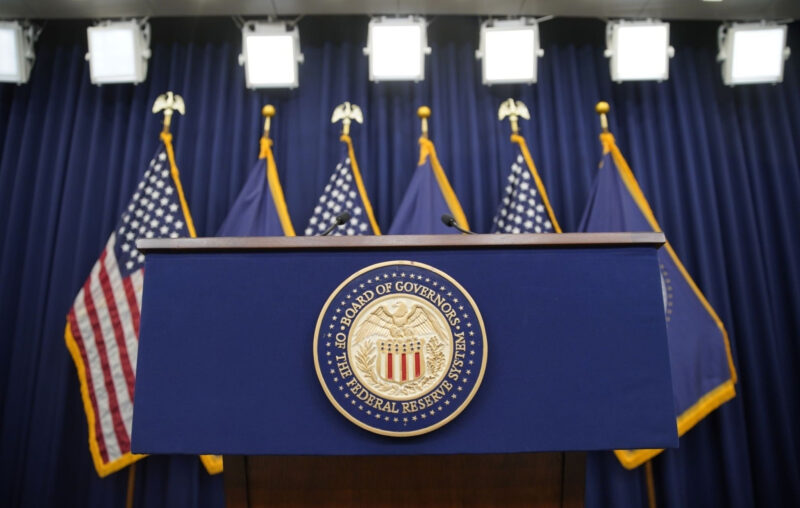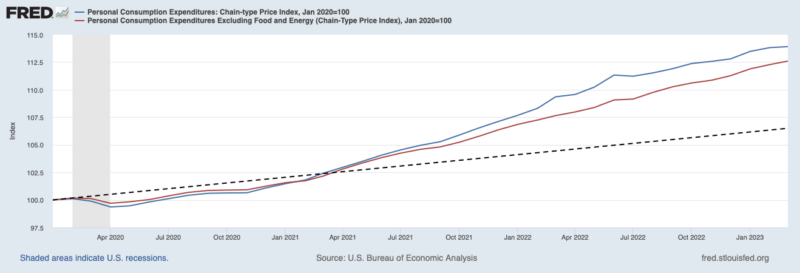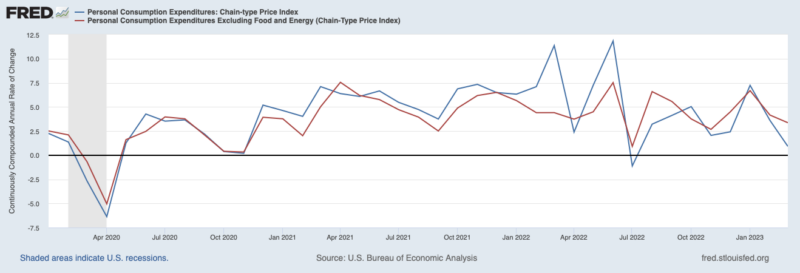
The Federal Reserve’s Federal Open Market Committee (FOMC) voted to raise its target rate range by 25 basis points on Wednesday. The FOMC has increased its target rate ten times in the past fourteen months. The target rate range is now 5.0 to 5.25 percent.
Fed officials say they are committed to achieving 2 percent inflation. “I think we’re always going to have 2 percent as our target,” Fed Chair Jerome Powell told journalists at the post-meeting press conference. “And we’re always going to be focused on getting there.”
Prices have grown rapidly since the start of the pandemic, really taking off in March 2021. The personal consumption expenditures price index (PCEPI), which is the Fed’s preferred measure of inflation, has grown at a continuously compounding annual rate of 4.1 percent since January 2020. Prices today are 7.4 percentage points higher than they would have been had the Fed hit its 2-percent average inflation target over the period.
Core PCEPI, which excludes volatile food and energy prices and is therefore thought to be a better predictor of future inflation, has grown at a continuously compounding annual rate of 3.7 percent since January 2020.

After rebounding in December and January, inflation has declined in recent months. Headline inflation was 0.9 percent in March, down from 7.2 percent in January and 3.6 percent in February. Core inflation remained elevated at 3.4 percent in March, down from 6.7 percent in January and 4.2 percent in February.

The FOMC’s most recent decision indicates an unwillingness to risk its rate target’s being anything but sufficiently restrictive. Recall that the Fisher equation says the real (inflation-adjusted) interest rate is equal to the nominal interest rate minus expected inflation. If markets expect the most recent monthly core inflation reading to persist in the near term, today’s hike takes the real federal funds rate target range to 1.6 to 1.85 percent. Many economists would put the neutral real federal funds rate at 0.25 to 0.5 percent.
It seems unlikely at this point that the FOMC will hike rates again when it meets in June. Powell said “a decision on a pause was not made today,” but also called attention to changes in the FOMC’s statement. In March, the FOMC anticipated “that some additional policy firming may be appropriate.” No longer. “In determining the extent to which additional policy firming may be appropriate to return inflation to 2 percent over time,” the most recent statement reads, “the Committee will take into account the cumulative tightening of monetary policy, the lags with which monetary policy affects economic activity and inflation, and economic and financial developments.”
The big question going forward is how long the Fed will hold its target at the current rate range. In March, the median FOMC member projected the federal funds rate target would close the year above 5.0 percent. But the federal funds futures market is pricing in better-than-even odds that the target rate is less than 5.0 percent following the September meeting.
At the post-meeting press conference, Powell pushed back against the expectation of rate cuts later this year:
We on the committee have a view that inflation is going to come down not so quickly — that it will take some time. And in that world — if that forecast is broadly right — it would not be appropriate to cut rates and we won’t cut rates. If you have a different forecast — and markets have been, from time to time, pricing in quite rapid reductions in inflation — we’d factor that in. But that’s not our forecast.
Of course, Powell has also said the FOMC is data-dependent. If the FOMC’s forecast changes, its policy will change as well.


0 Comments